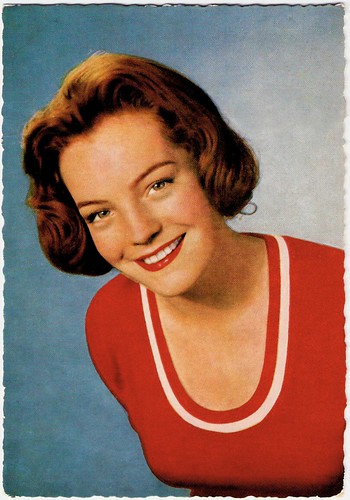
German postcard by WS-Druck, Wanne-Eickel, no. F 45. Photo: Ringpress / Vogelmann / NDF.

Dutch postcard by Gebr. Spanjersberg N.V., Rotterdam, no. 1020. Photo: UFA (Universum-Film Aktiengesellschaft), Berlin-Tempelhof.

German postcard by Ufa, no. CK-204. Photo: Vogelmann / Ufa.
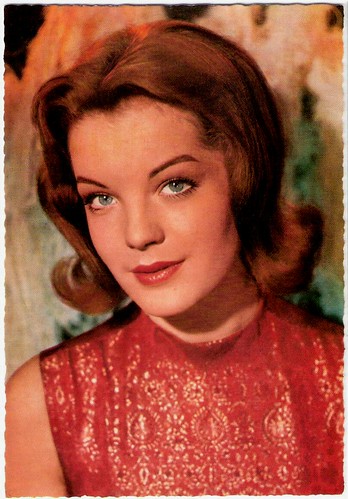
German postcard by W.S. Druck, Wanne-Eickel, no. F 19. Photo: Ringpress / Vogelmann / NDF.

French postcard by Editions du Globe, Paris. Photo: Sam Lévin.
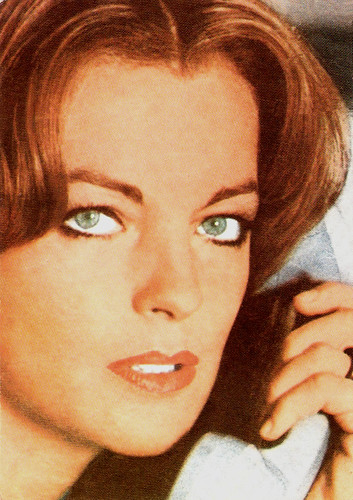
Romanian postcard by Casa Filmului Acin. Photo: publicity still for Les choses de la vie/The Things of Life (Claude Sautet, 1970).
Rosemarie
Romy Schneider was born Rosemarie Magdalena Albach in Vienna, Austria, in 1938. She was almost predestined to become an actress, because her family included many successful actors such as her grandmother Rosa Albach-Retty, her Austrian father Wolf Albach-Retty and her German mother Magda Schneider.
After her parents' divorce in 1945, her mother took charge of Romy and her brother Wolfi (Wolfgang). Romy attended a school in Berchtesgaden, and Pensionnat Goldstein in Salzburg.
At the age of 15, she made her film debut. It was an important supporting part in Wenn der weisse Flieder wieder blüht/When the White Lilacs Bloom Again (Hans Deppe, 1953) starring Willy Fritsch and her mother, Magda Schneider. Magda went on to supervise her young daughter's career, and she would often appear alongside Romy.
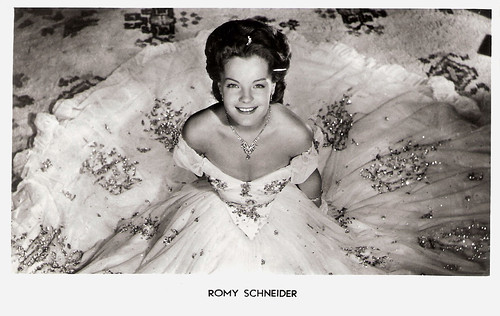
Dutch postcard.

Dutch postcard by Takken, no. 3092. Photo: Filmex NV. Publicity still for Sissi - Die junge Kaiserin/Sissi: The Young Empress (Ernst Marischka, 1956) with Magda Schneider.

Dutch postcard by Uitg. Takken, Utrecht, no. 1980. Photo: Filmex N.V. With Karl Heinz Böhm.

Dutch postcard by Gebr. Spanjersberg. Photo: Ufa/Film-Foto. The photo was made during the shooting of Sissi - Schicksalsjahre einer Kaiserin/Sissi: The Fateful Years of an Empress (Ernst Marischka, 1957) with Magda Schneider.

Dutch postcard by N.V. Int. Filmpers (I.F.P.), Amsterdam, no. 1027. With Karl Heinz Böhm.
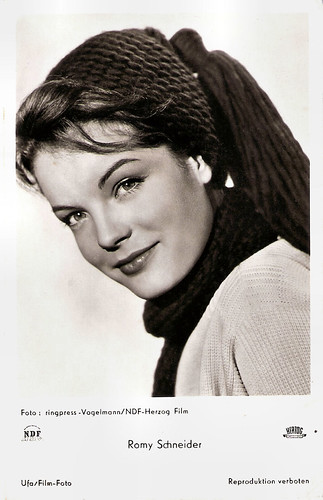
German postcard by Ufa, Berlin-Tempelhof, no. FK 3451. Photo: Ringpress / Vogelmann / NDF / Herzog-Film.
Sissi
Romy Schneider portrayed a royal for the first time in her next film, Mädchenjahre einer Königin/The Story of Vickie (Ernst Marischka, 1954). She played the young, soon-to-be Queen Victoria opposite Adrian Hoven as her beloved Prince Albert.
She also appeared in the musical Feuerwerk/Fireworks (Kurt Hoffmann, 1954) with Lilli Palmer, and Der Lezte mann/The Last Man (Harald Braun, 1954), an all-talking remake of the 1924 silent classic by F.W. Murnau. Hans Albers tried to replace Emil Jannings (but failed).
Instant stardom came with her portrayal of Empress Elisabeth of Austria in Sissi (Ernst Marischka, 1955). Her incredibly charming performance is the heart of this wildly successful film. The cast also included Karl Heinz Böhm as the young emperor Franz Joseph, Vilma Degischer as his mother, Archduchess Sophie, Gustav Knuth as Sissi's father Duke Max, and Magda Schneider as his wife Duchess Ludovika.
Romy Schneider shines as the young princess. Millions of cinemagoers fell in love with her gorgeous smile and her sweet manners.
In the following years she appeared in two equally successful sequels, Sissi - Die junge Kaiserin/Sissi: The Young Empress (Ernst Marischka, 1956) and Sissi - Schicksalsjahre einer Kaiserin/Sissi: The Fateful Years of an Empress (Ernst Marischka, 1957). Schneider had become the darling of the European public.

German postcard by Ufa, Berlin-Tempelhof, no. FK 3454. Photo: Ringpress / Vogelmann / NDF / Herzog-Film. Publicity still for Robinson soll nicht sterben/The Legend of Robinson Crusoe (Josef von Báky, 1957).
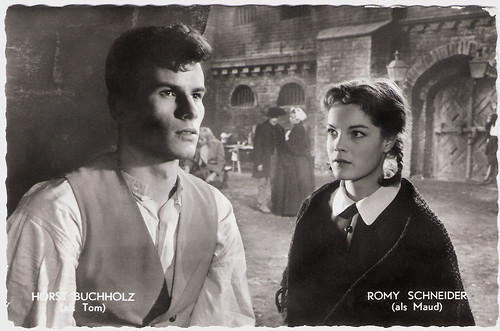
Dutch postcard by I.F.P. (Drukkerij Uitg. Int. Filmpers), Amsterdam, no. 1092. Photo: publicity still for Robinson soll nicht sterben/The Legend of Robinson Crusoe (Josef von Báky, 1957) with Horst Buchholz.
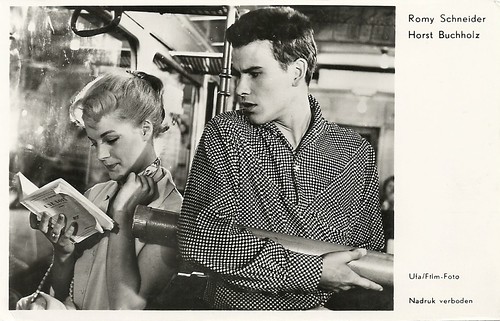
Dutch postcard by Gebr. Spanjersberg, Rotterdam, no. 1022. Photo: Ufa. Publicity still for Monpti/Love from Paris (Helmut Käutner, 1957) with Horst Buchholz.
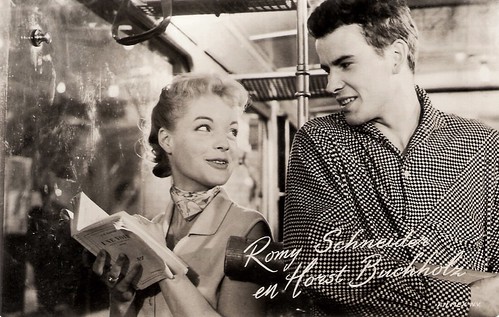
Dutch postcard by Takken, Utrecht, no. AX 3179. Photo still with Romy Schneider and Horst Buchholz in Monpti/Love from Paris (Helmut Käutner, 1957) with Horst Buchholz.

Dutch postcard by Uitg. Takken, Utrecht, no. 3175. Photo: Filmex NV. Publicity still for Monpti/Love From Paris (Helmut Käutner, 1957).
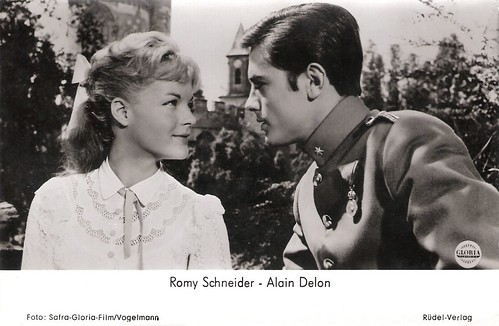
German postcard by Franz Josef Rüdel Filmpostkartenverlag, Hamburg-Bergedorf, no. 2638. Photo: Safra / Gloria-Film / Vogelmann. Publicity still for Christine (Pierre Gaspard-Huit, 1958) with Alain Delon.
Monpti
After Sissi Romy Schneider soon became nauseated by the saccharine ‘nice girl’ image. She desperately wanted to act in less stereotypical films.
She teamed up with Horst Buchholz in Robinson Soll nicht sterben/The Girl and the Legend (Josef von Báky, 1957) which dealt with Daniel Defoe's childhood. She and Buchholz were then Germany's biggest stars, and the next year they starred again together in the love story Monpti/Love From Paris (Helmut Käutner, 1957).
At AllMovie, Hal Erickson writes: "What starts as a light-hearted romp unexpectedly deepens into tragedy. The film is narrated by a wry, all-knowing Parisian who, at closer inspection, turns out to be director Helmut Kautner."
During the shooting of Christine (Pierre Gaspard-Huit, 1958) she fell in love with her co-star, Alain Delon, Romy left Germany to join her handsome fiancé in Paris.
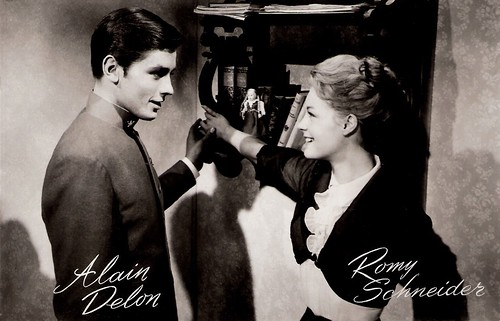
Dutch postcard by Uitg. Takken, Utrecht, no. 3922. Photo: N.V. Meteor Film, Amsterdam/Spava-Play Art Prod. Still from Christine (Pierre Gaspard-Huit, 1958) with Alain Delon.
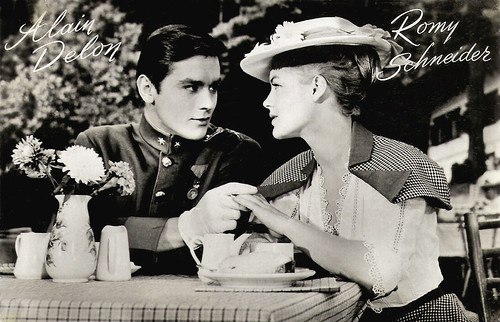
Dutch postcard by Takken, Utrecht. Photo: NV Meteor Film. Publicity still for Christine (Pierre Gaspard-Huit, 1958) with Alain Delon.
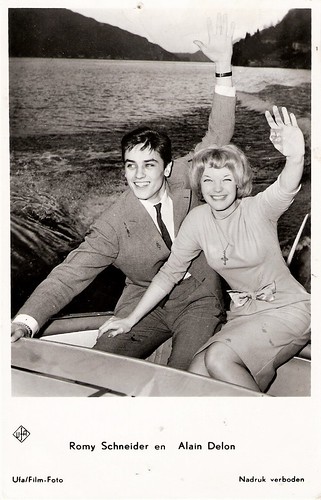
Dutch postcard by Gebr. Spanjersberg, Rotterdam, no. 1207, ca. 1959. Photo: Ufa/Film-foto. This happy picture was shot at the engagement party of Romy Schneider and Alain Delon.

French postcard by Editions P.I., Paris, no. FK 4457. Photo: UFA. This happy picture was shot at the engagement party of Romy Schneider and Alain Delon.

Dutch postcard by Gebr. Spanjersberg N.V., Rotterdam, no. 1204/559. Photo: Universum-Film Aktiengesellschaft (UFA), Berlin-Tempelhof. Caption: "Gay picture of Romy Schneider during her engagement party." With her brother Wolfi.
Luchino Visconti
Romy Schneider stayed in Paris and would have a hugely successful film career in France. But first she had to continue making films in the German film industry. She had refused Ernst Marischka to play in the fourth part of Sissi, and different films were created for her in the lead in order to keep her 'home'.
While Alain Delon was having his international breakthrough with the excellent thriller Plein Soleil/Purple Noon (René Clément, 1960) and the incredibly beautiful Rocco e i suoi fratelli/Rocco and His Brothers (Luchino Visconti, 1960), Schneider was forced to appear in mediocre German-French productions like Ein Engel auf Erden/An Angel on Wheels (Géza von Radványi, 1959), Die schöne Lügnerin/The Beautiful Liar (Axel von Ambesser, 1959), the Sissi-like costume romance, Katia/Adorable Sinner (Robert Siodmak, 1959) with Curd Jürgens, and the worst of these films, Die Halbzarte/Eva (Rolf Thiele, 1959) with Carlos Thompson.
Then Delon introduced her to Luchino Visconti. Visconti offered Schneider her first theatre engagement, in John Ford's stage play 'Tis Pity She's a Whore. Despite having to act in French, she won audience and critical acclaim.
Visconti directed her again in the segment Il lavoro (The Work) of the episodic film Boccaccio '70 (1962). At IMDb, Ubaldo Martinez writes: "The one thing I remembered about Bocaccio '70 was Romy Schneider getting dressed in front of a mirror, in front of us. The film in his 4 segments has much more, but nothing better than Romy Schneider in the Visconti segment. She is exquisite of course but in Visconti's hands she is superlative. Visconti, like George Cukor, knew how to guide actresses to their best."
Schneider had also gained the interest of Orson Welles who directed her in his excellent Le procès/The Trial (1962), based on the novel by Franz Kafka.

Dutch postcard. Photo: publicity still for Kitty und die grosse Welt/Kitty and the Great Big World (Alfred Weidenmann, 1956) with Paul Dahlke.
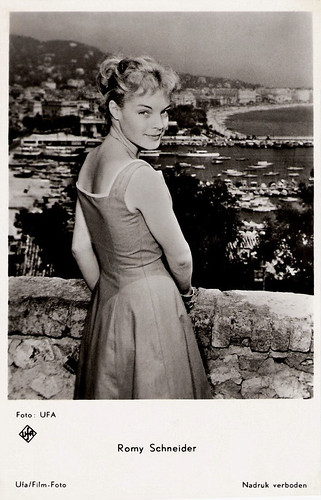
Dutch postcard by Gebr. Spanjersberg N.V., Rotterdam, no. 3651. Photo by UFA, Berlin. Publicity still for Scampolo (Alfred Weidenmann, 1958), filmed on location at Ischia Island, Naples and Campania in Italy.
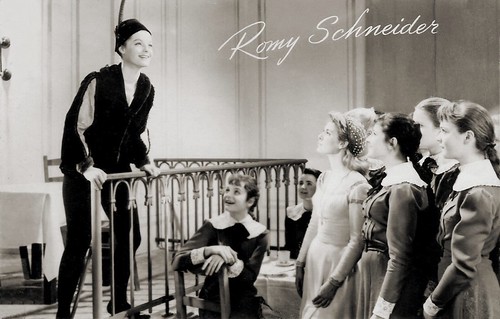
Dutch postcard by Takken, Utrecht (printed by 't Sticht), no. AX 3879, posted by mail in 1959. Photo: Grimm / C.C.C. / Gloria. Publicity still for Mädchen in Uniform/Girls in Uniform (Géza von Radványi, 1958).
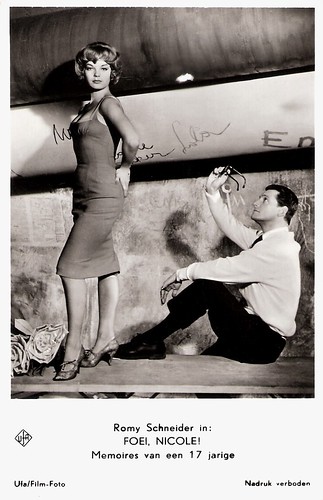
Dutch postcard by Gebr. Spanjersberg N.V., Rotterdam (Dutch licency holder fot Ufa), no. 1179. Photo:Ufa/Film-foto. Publicity still for Die Halbzarte/Eva (Rolf Thiele, 1959) with Carlos Thompson.

Dutch postcard by Uitgeverij Takken, Utrecht, no. 3942.
Hollywood
Although Romy Schneider and Alain Delon lived together for five years, they never married. James Travers at Films de France writes that "Delon had been having an affair with another woman, Nathalie Barthélemy, whom he chose to marry on learning she was pregnant with his child. Although the separation was painful (Delon couldn’t bring himself to face Romy at their parting; he just left her a note saying goodbye), the two actors later renewed their friendship and remained on the best of terms, with Delon dispensing both moral and financial support during periods of crisis."
Schneider then had a brief stint in Hollywood including appearances in the war film The Victors (Carl Foreman, 1963) and the comedy What’s New Pussycat? (Clive Donner, Richard Talmadge, 1965) with Peter Sellers. Schneider returned to France.
She had a starring role in L’Enfer/Inferno (Henri-Georges Clouzot, 1964), although the film was aborted when Clouzot suffered a fatal heart attack. Recently the film has been restored and was finally shown in cinemas over the world.
In La Voleuse/The Thief (Jean Chapot, 1966), she appeared for the first time alongside Michel Piccoli, who would become one of her closest friends. By this time, Romy had married, to the theatre director Harry Meyen, and had given birth to a son, David.
Scheider had remained friends with Delon and they appeared together in some excellent films, including La Piscine/The Swimming Pool (Jacques Deray, 1968) and The Assassination of Trotsky (Joseph Losey, 1972). She also worked again with Visconti. She featured in Ludwig (Luchino Visconti, 1972) about the life of King Ludwig II of Bavaria (Helmut Berger), as a much more complex, mature, even bitter and cold Elisabeth of Austria. She erased any trace of the sweet Sissi character.
Schneider's leading role in the harsh but beautiful L'important c'est d'aimer/The Main Thing Is to Love (Andrzej Zulawski, 1974) garnered her the first César Award. At AllMovie, Yuri German writes about the film: "Set in a world of losers and futile talents, this dark and moody drama depicts love as the only source of salvation. Memorable performances and skilful direction make this film a powerful experience."

French postcard by Editions P.I., Paris, no. 1086. Photo: Sam Lévin. Publicity still for Boccaccio '70. She appeared in the episode Il lavoro (The Job), directed by Luchino Visconti. She is wearing a Coco Chanel's tailleur.
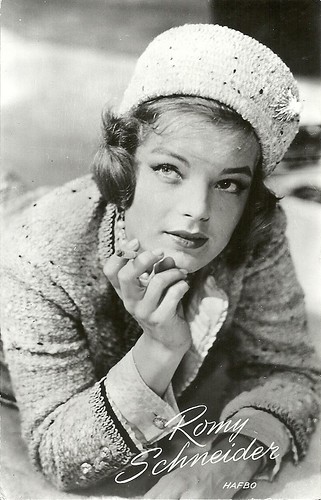
Dutch postcard. Photo: HAFBO. Romy Schneider dressed in Chanel in the episode Il lavoro/ The Job (1961) by Luchino Visconti, part of the episodefilm Boccaccio '70.
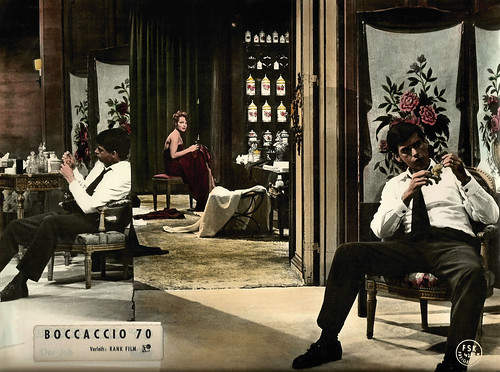
Publicity still used in Germany, distributed by Rank, mark of the German censor FSK. Thomas Milian & Romy Schneider in Luchino Visconti's episode Il Lavoro in the episode film Boccaccio 70 (1962). Milian plays a bored aristocrat, caught in a scandal with callgirls. Schneider plays his rich and equally bored Austrian wife, who tries to seduce her husband and make him pay for love just like he did with his callgirls. It works, but leaves the woman with bitterness. The set of the film was terribly costly because of all the authentic, valuable objects present.

German postcard by Poster XXL. Photo: Sam Lévin.

French postcard by E.D.U.G., no. 284. Photo: Sam Levin.
Claude Sautet
Romy Schneider appeared with her good friend Michel Piccoli in Les choses de la vie/The Things of Life (Claude Sautet, 1970). Claude Sautet was so taken with her that he gave her substantial roles in four subsequent films: Max et les ferrailleurs/Max and the Junkmen (1971), César et Rosalie/César and Rosalie (1972), Mado (1976), and Une histoire simple/A Simple Story (1978). It was for her moving portrayal of an independent woman in the latter film that Romy won her second César in 1979.
With these films she had created a new persona: the modern sexually liberated woman. In La mort en direct/Death Watch (Bertrand Tavernier, 1980) with Harvey Keitel, she played a dying woman whose last days are watched on national television via a camera implanted in the brain of a journalist.
Her last film was La Passante du Sans-Souci/The Passerby (Jacques Rouffio, 1982) with Michel Piccoli and Helmut Griem.
Romy Schneider suffered the hardest blow of her life when her 14-year-old son David was impaled on a fence in 1981. She never managed to recover from this loss and died a year later. Although it was suggested she committed suicide caused by an overdose of sleeping pills, she was declared to have died from cardiac arrest. Alain Delon arranged for David to be buried in the same grave as his mother.

French postcard by E.D.U.G., no. 70. Photo: Sam Lévin.
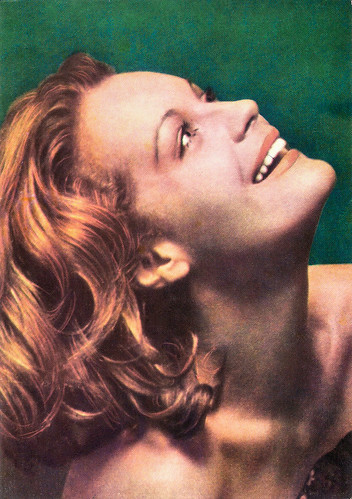
Romanian postcard by Casa Filmului Acin.
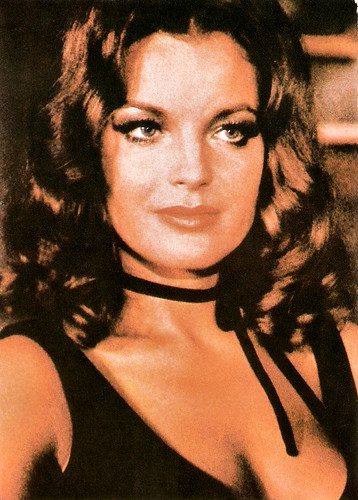
French postcard by Editions F. Nugeron, no. Star 41. Publicity still for Max et les ferrailleurs/Max and the Junkmen (Claude Sautet, 1971).
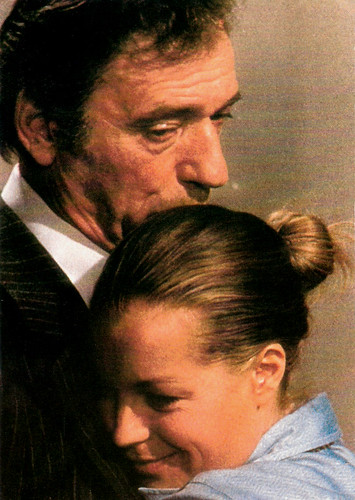
French postcard by Editions Nugeron in the Star Series, no. 58. Photo: publicity still for Clair de femme/Womanlight (Costa Gravas, 1979) with Yves Montand.
Trailer of Sissi (1955). Source: UweundPiaFan (YouTube).
Trailer of The Trial (1962). Source: Danios12345 (YouTube).
Italian trailer of Ludwig (1972). Source: CG Entertainment (YouTube).
Trailer L'important c'est d'aimer/The Main Thing Is to Love (1974). Source: Fury (YouTube).
Sources: James Travers (Films de France), Yuri German (AllMovie), Ubaldo Martinez (IMDb), Ulrike Sieglohr (Filmreference.com), Hal Erickson (AllMovie), Wikipedia, and IMDb.
I always enjoy reading your posts!
ReplyDeleteHowdy Bob
ReplyDeleteOh wow this was wonderful !
Happy PFF to you :)
I really enjoyed watching the film clips . What a gorgeous woman and so elegant too .
With her family background it is true she was destined to be great.
Thank you for making my day .
Have a fantastic weekend.
Until next time
Happy Trails
I was trying to remember what film I had seen her in and thought I would discover as I read on, but then, to be continued...oh no. I will have to wait to discover but will content myself by looking at the gorgeous Horst Buchholz.
ReplyDeleteWonderful, wonderful. It's always fun to visit. For some reason, Romy Schneider seems familiar...perhaps I'll learn more in Part 2!!!!!! Happy PFF!
ReplyDeleteThank you. I know the name but not the performances.
ReplyDeleteHappy PFF!
ReplyDeleteHi everybody,
ReplyDeleteThanks for stopping by. Sorry Joy, I had so many Romy Schneider cards that I had to divide the post in three parts. Today and tomorrow, part 2 and 3. Have a good weekend.
Bob
I hadn't realised she died so long ago. I'm late coming around so I can now read the later post. :)
ReplyDeleteAs always, your posts are fascinating. Romy was a beautiful woman. I recognize her from old movies, seen long ago. Your descriptions are flawlessly interesting and beautifully written. Thank you so much for posting with Postcard Friendship Friday! It is good to "see" you again. :D
ReplyDelete